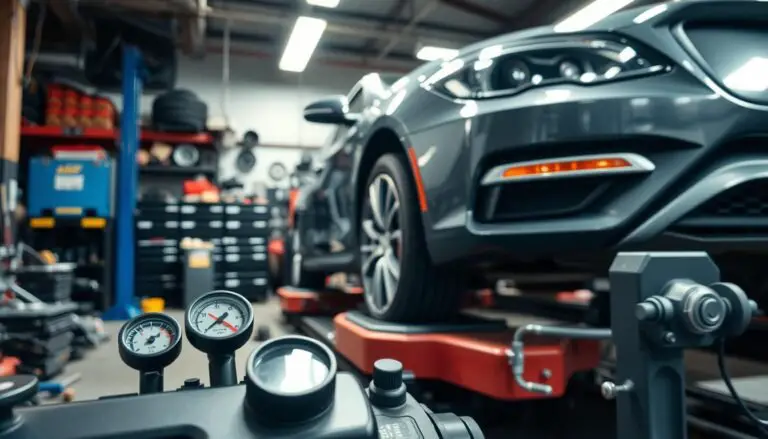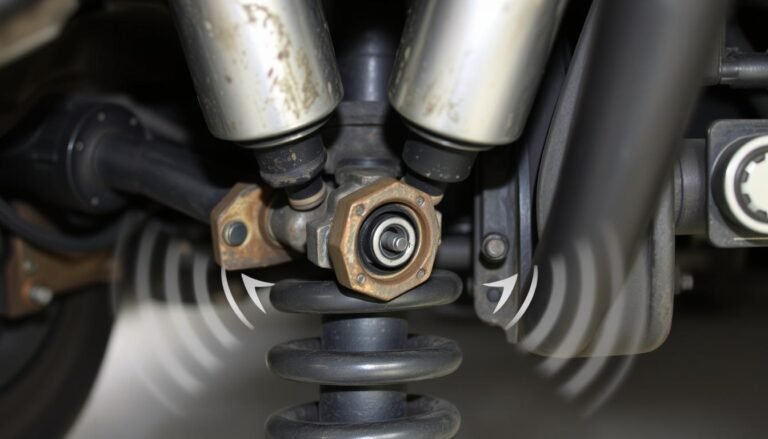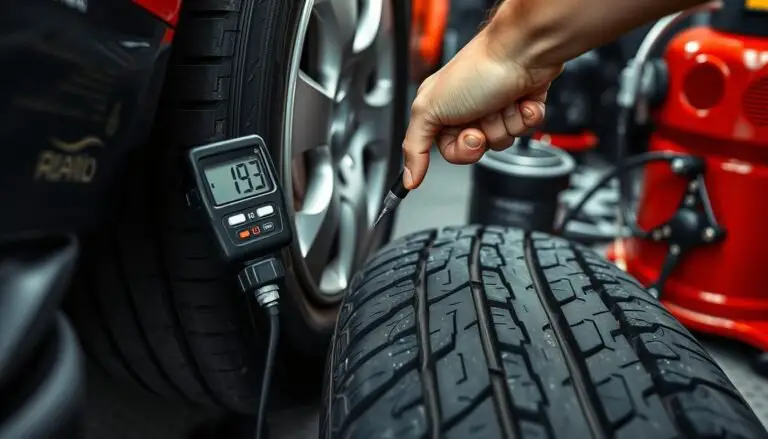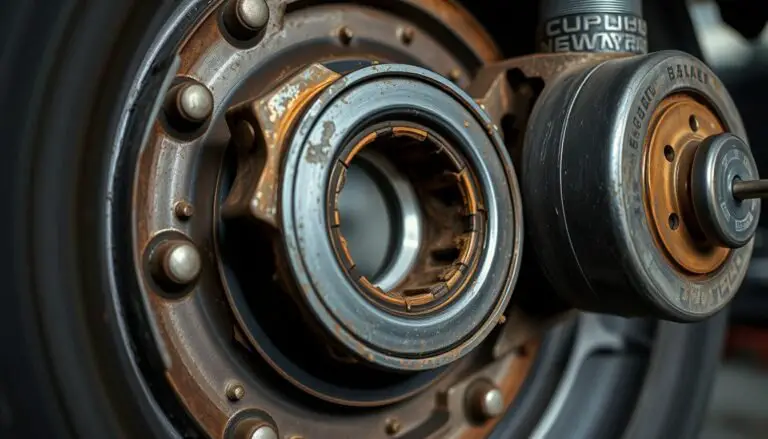What is the Proper Tire Pressure for my Car?
Keeping your tires at the right pressure is key for your car’s best performance and safety. Your tires are the only part of your car that touches the road. So, making sure they’re inflated correctly is very important.
In this article, we’ll talk about why tire pressure matters. We’ll also share the best PSI levels for your car. Plus, we’ll explain the risks of tires that are too low or too high.
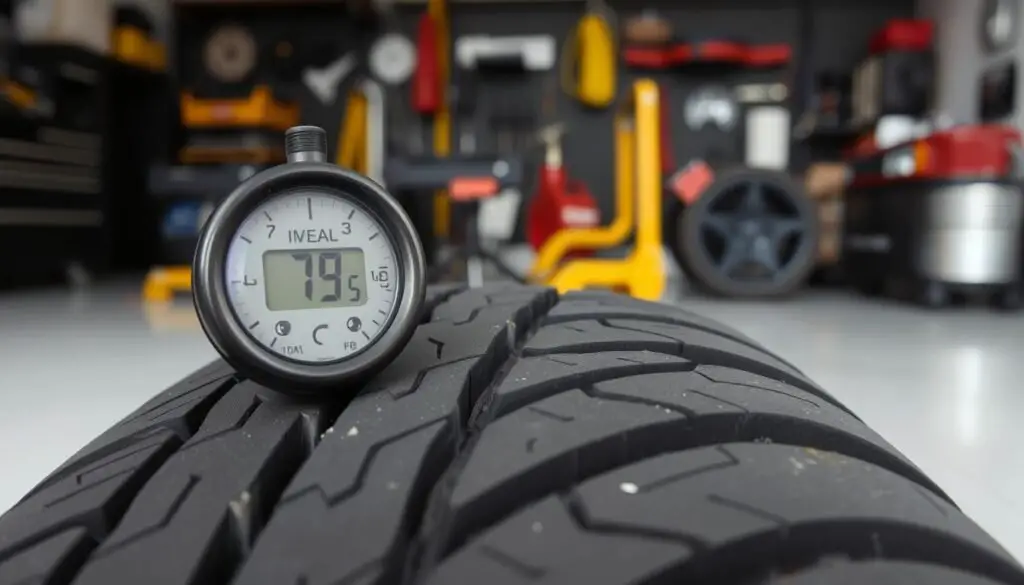
Knowing the right tire pressure can make your car more fuel-efficient. It also helps your tires last longer and makes your drive smoother and safer. We’ll look at how the Tire Pressure Monitoring System (TPMS) works. And we’ll share tips on keeping your tires in great shape.
Understanding Tire Pressure Importance
Keeping your tires at the right pressure is key for your car’s performance, safety, and how much fuel it uses. The tire pressure monitoring system (TPMS) in your car tells you when the pressure is too low. It’s a vital part of keeping your car in good shape.
Tire Pressure Monitoring System
The TPMS checks the air in your tires and tells you if it’s off. If the pressure gets too low, it lights up a warning on your dashboard. This helps you fix the problem before it gets worse, keeping you safe and your tires lasting longer.
Vehicle Maintenance Essentials
Keeping your tires at the right pressure is a big part of taking care of your car. It makes your car safer and more fuel-efficient, saving you money. Make sure to check your tire pressure regularly, along with other car care tasks.
| Benefit | Impact |
|---|---|
| Improved Safety | Properly inflated tires provide better traction, handling, and braking, reducing the risk of accidents. |
| Enhanced Fuel Efficiency | Tires with the correct pressure require less energy to roll, leading to improved fuel economy. |
| Longer Tire Life | Maintaining the recommended tire pressure helps prevent premature wear and tear, extending the life of your tires. |
By knowing how important tire pressure is and keeping up with your TPMS, you’ll have a safer, more efficient, and better-performing car. This makes your car safer and more reliable, improving your overall driving experience.
Recommended PSI Levels
Finding the right tire pressure is key for your car’s performance and safety. The correct pressure is specific to your car’s make and model. You can find it in your owner’s manual or on the driver’s side door jamb sticker.
Finding Your Vehicle’s Specifications
To find the PSI your car needs, check these places:
- Owner’s manual: This guide from the manufacturer has all the details, including the PSI for your tires.
- Driver’s side door jamb sticker: This sticker on the driver’s side door frame shows the vehicle specifications, like the PSI for your tires.
- Tire information placard: You’ll find this placard in the driver’s side door jamb or glove compartment. It lists the PSI levels for your tires.
By looking at these sources, you can make sure your tires are at the right PSI. This improves your car’s performance and safety.
| Vehicle Make | Model | Recommended PSI |
|---|---|---|
| Ford | F-150 | 35 PSI |
| Toyota | Camry | 30 PSI |
| Honda | Civic | 32 PSI |
| Chevrolet | Silverado | 35 PSI |
Keeping your tires at the recommended PSI is crucial. It ensures your car performs well, handles well, and is safe.
Dangers of Underinflated Tires
Driving on underinflated tires is risky for your vehicle, safety, and wallet. Underinflated tires cause many problems that should not be ignored.
Increased Tire Wear
Underinflated tires get hotter and wear down faster. This quick wear reduces their life and affects their grip and handling.
Reduced Fuel Efficiency
Underinflated tires need more energy to move, leading to more fuel consumption and less fuel efficiency. This affects your car’s performance and costs.
| Tire Condition | Impact on Fuel Efficiency |
|---|---|
| Properly Inflated Tires | Optimal fuel efficiency |
| Underinflated Tires | Decreased fuel efficiency by up to 3% |
To keep your vehicle safe, efficient, and performing well, check and adjust the tire pressure regularly. This helps avoid the risks of underinflated tires.
“Proper tire inflation is not only crucial for safety, but it can also significantly impact your vehicle’s fuel efficiency and overall performance.”
What is the proper tire pressure for my car?
Keeping your car’s tire pressure right is key for its best performance, safety, and fuel use. The correct pressure is listed in your owner’s manual or on a sticker on the driver’s side door jamb.
The pressure needed for your car is usually in pounds per square inch (PSI). It changes based on your car’s make, model, and year. Always check your tire pressure and keep it at the right level for your car to run well.
- Underinflated tires can lead to decreased fuel economy, premature tire wear, and even blowouts.
- Overinflated tires can result in a harsh ride, reduced traction, and an increased risk of punctures.
Keeping your tire pressure right is a simple but important task. It greatly affects your car’s performance and safety. By following the manufacturer’s advice, you ensure your tires work their best and your car runs smoothly.
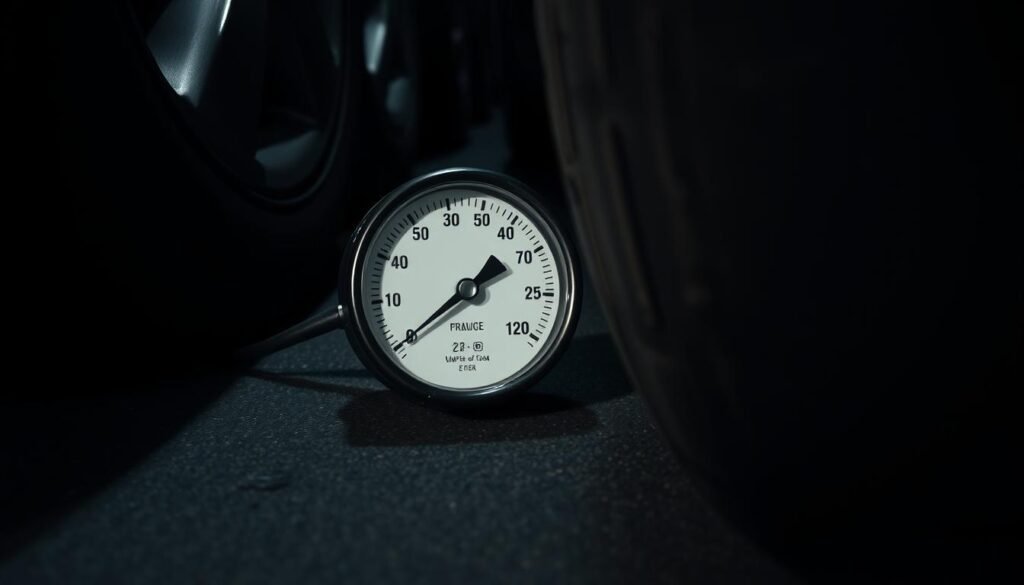
“Proper tire pressure is the foundation of a vehicle’s handling, safety, and fuel efficiency.”
Overinflated Tires and Their Risks
Underinflated tires can cause problems, but overinflated overinflated tires have their own risks. They can make the ride rough, wear down the center of the tread, and reduce traction. This can affect handling and safety.
The main danger of overinflated tires is the higher risk of a blowout. Overinflated tires have stiffer sidewalls that can’t handle road hazards well. This can cause a sudden blowout, leading to loss of control and accidents.
Overinflated tires also reduce traction and stability. The stiff sidewalls and less contact with the road make the vehicle more likely to skid or hydroplane. This is especially true in wet or slippery conditions.
| Consequence | Impact |
|---|---|
| Rougher ride | Decreased comfort and control |
| Increased tread wear in the center | Reduced tire lifespan |
| Reduced traction | Compromised handling and safety |
To avoid the risks of overinflated tires, check your tire pressure regularly. Make sure it’s at the recommended level by the manufacturer. Proper tire pressure ensures a smooth, safe, and comfortable ride.
Adjusting Tire Pressure for Driving Conditions
Proper tire pressure isn’t the same for everyone. It changes based on where and how you drive. Knowing how to adjust your tire pressure is key for better performance and safety.
Highway Driving
For driving on highways, your car’s maker usually sets the right tire pressure. This pressure makes your ride smooth and helps you save gas. But, if you carry heavy loads or tow a trailer, you might need to add a bit more air. This keeps your vehicle stable and prevents tire wear.
Off-Road Adventures
Off-roading requires a different approach to tire pressure. Lowering the pressure a bit helps your vehicle grip better on rough terrain. This makes your ride smoother and lowers the chance of getting stuck. Remember to go back to the recommended pressure for highway driving.

Checking and keeping the right tire pressure is vital, no matter where you drive. It keeps you safe and makes your tires last longer. By doing this, you’ll have a better, safer, and more enjoyable drive, whether on the open road or off the beaten path.
Tire Pressure and Automotive Safety
Proper tire pressure is key for your car’s automotive safety. It’s not just about saving fuel and extending tire life. It’s about keeping you safe on the road.
Underinflated tires can cause your car to lose traction. This makes it harder to control, especially when you need to stop quickly. Overinflated tires, on the other hand, can make your ride uncomfortable. They also reduce your car’s grip on the road, making it harder to steer in wet conditions.
Keeping your tires at the right pressure is vital. It ensures your car handles well, brakes effectively, and stays stable. This helps prevent accidents and keeps everyone in your car safe.
Tire Pressure and Vehicle Handling
The pressure in your tires affects how your car handles. The right pressure means your car steers smoothly, corners well, and brakes reliably. But, the wrong pressure can cause problems:
- Reduced steering responsiveness and control
- Increased risk of hydroplaning on wet roads
- Longer braking distances and decreased brake effectiveness
- Decreased vehicle stability, especially during sudden maneuvers or high-speed driving
Tire Pressure and Tire Wear
Proper tire pressure also helps your tires last longer. Underinflated tires wear down faster on the outside. Overinflated tires wear down in the center. This uneven wear can shorten your tire’s life and reduce its safety.
By keeping your tires at the right pressure, you ensure your car’s safety and performance. This makes driving safer for you and your passengers.
Checking Tire Pressure Regularly
Keeping your tires at the right pressure is key for your car’s performance, safety, and gas use. It’s important to check tire pressure often. You can do it yourself or have a pro do it. Making sure your tires are at the right PSI is easy and makes a big difference.
DIY Tire Pressure Checks
Checking tire pressure at home is simple and quick. You just need a good tire pressure gauge, which you can buy at auto parts stores or online. Here’s how to do it:
- Find the recommended tire pressure for your car in your owner’s manual or on the driver’s side door jamb sticker.
- Let your tires cool down for at least 30 minutes before checking. Driving warms up the tires, which can change the reading.
- Use your tire pressure gauge to check the PSI in each tire, including the spare. Make sure the valve stems are clean and easy to reach.
- Compare the readings to the recommended PSI and adjust the tire pressure as needed, adding air or releasing it.
Regularly checking tire pressure and keeping it right can make your tires last longer, save gas, and improve your car’s handling and safety.
“Proper tire inflation is one of the most important maintenance tasks you can perform on your vehicle. It’s quick, easy, and can have a significant impact on your driving experience.”
By spending a few minutes to check your tire pressure at home, you can make sure your car is in top shape. This helps avoid the dangers and hassles of tires that are not the right pressure.
Professional Tire Pressure Services
If you’re not sure about the right tire pressure for your car, a professional service center is a great place to go. They can help you understand the correct PSI levels. This ensures your tires are at the right pressure, improving both performance and safety.
At a service center, experts will check your tires and adjust the pressure if needed. They make sure your tires match the manufacturer’s standards. This can make your tires last longer, save fuel, and make driving better.
Whether you’re going on a long trip or just want to keep your car in good shape, professional tire services are a smart choice. They have the knowledge and tools to make sure your tires are ready for any road. You can feel confident that your car is in top condition.
FAQ
What is the proper tire pressure for my car?
The right tire pressure for your car is listed in your owner’s manual. You can also check the driver’s side door jamb sticker. Keeping your tires at this pressure is key for your car’s performance and safety.
What is a tire pressure monitoring system?
The tire pressure monitoring system (TPMS) in your car warns you when the pressure is too low. It’s important to keep your tires at the right pressure for your car’s maintenance.
Why is vehicle maintenance important?
Keeping your tires at the right pressure is vital for your car’s performance, safety, and fuel efficiency. It’s a crucial part of taking care of your vehicle.
How do I find the recommended PSI levels for my vehicle?
The right tire pressure, in pounds per square inch (PSI), varies by car model. You can find it in your owner’s manual or on the driver’s side door jamb sticker.
What are the dangers of underinflated tires?
Driving on underinflated tires can cause tire wear, lower fuel efficiency, and affect handling and safety. They also get hotter, leading to wear and failure.
What are the risks of overinflated tires?
Overinflated tires can make your ride harsher, wear out faster in the center, and reduce traction. This can make handling and safety worse.
How do I adjust tire pressure for different driving conditions?
You might need to adjust tire pressure for different driving conditions. For highway driving, the recommended PSI is usually fine. But for off-road or heavy loads, slightly lower pressure can help with traction and comfort.
How does tire pressure affect automotive safety?
Proper tire pressure is not just about fuel and wear; it’s also about safety. Incorrect pressure can affect handling, braking, and stability, leading to dangerous situations.
How can I check my tire pressure regularly?
You can check tire pressure yourself with a handheld gauge or get a professional check at a service station.
When should I seek professional tire pressure services?
If you’re unsure about your car’s tire pressure or need help, visit a professional service center. They can guide you and ensure your tires are at the right pressure for safety and performance.


